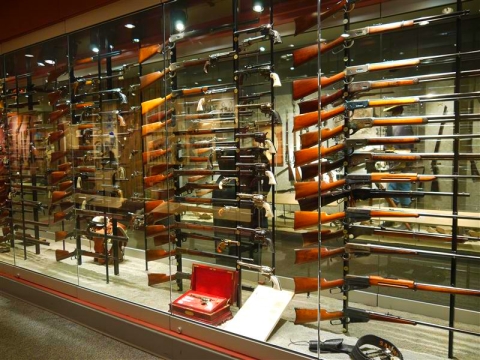
Sharps Breech-Loading Rifle
Could Christian Sharps have had any idea of the enduring American classic he created with his 1848 “Patent No. 5,763, Breech-Loading Fire-Arm”—a self-capping gun with sliding breech-pin?
- It loaded at the breech, with one charge—a clean, self-contained cartridge of linen or paper—placed in the main barrel “on a line with the bore.”
- It could be loaded only when the trigger-guard lever was down, dropping the breechblock.
- The “lever with high power” closed the barrel “perfectly tight.” In the process, a sharp-edged breech slide rose to slice off the end of the cartridge.
- For priming, a cap nipple was accessible to the hammer only once the breech was secure, making loading safer.
- A tube feed of pellets or percussion caps could be used to prime the nipple, allowing an astonishing eight to 10 firings per minute.
- Its design kept moving parts from heating, expanding and “tightening”—a common problem.
Bleeding Kansas
The “Beecher’s Bibles” shipped to abolitionist Free Soilers in Kansas were Model 1853 carbines. The Reverend Henry Ward Beecher of New England—the brother of Harriet Beecher Stowe of Uncle Tom’s Cabin—had observed that the “Sharps Rifle was a truly moral agency,” each possessing “more moral power” than a hundred Bibles.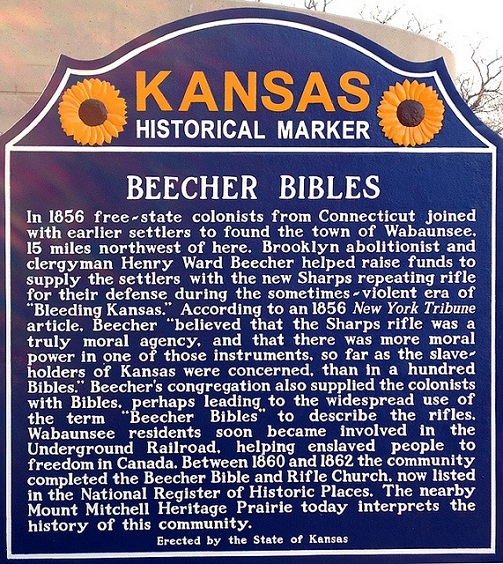
American Civil War
Over the course of the war, the U.S. government purchased 80,000 Sharps carbines and nearly 10,000 Sharps rifles. The government still issued well over a million rifle muskets to the vast majority of Union troops, fearing that the ease of loading Sharps cartridges would result in wasteful ammunition practices. However, it was a must-have for cavalry and elite units needing to reload on horseback or in covert settings, for example:- The 2nd U.S. Volunteer Sharpshooter Regiment—aka Berdan’s Sharpshooters—favored the New Model 1859 rifle.
- The 5th New York Volunteer Infantry, a unit known as “Duryée’s Zouaves,” was also known to have carried it.
- The first shot fired at the Battle of Gettysburg is credited to a Sharps, and the federal cavalry at the battle had more than 4,700 of the carbines in action.
The West
Model 1874 was often referred to as “Old Reliable,” the “buffalo rifle.” Reworked under the revamped Sharps Rifle Co., it was also a favorite of competitive shooters as Sharps were noted for accuracy and individual “personalities.” They came in a variety of sizes—barrel lengths and shapes, optional double-set triggers as well as to-order sights and butt plates. Custom cartridges allowed for powerful calibers like the “Poison Slinger” and “Big Fifty” that riflemen could reload to suit their own personal tastes. Bat Masterson and Bill Tilghman each carried one. “Wild Bill” Hickok did as well. Despite his love of Winchesters, even Theodore Roosevelt had a .45-caliber Sharps.Today
Rifle or carbine, sporting, military, target or custom, the various iterations of Sharps drew to a close in 1881 thanks to the repeating rifle. With only about 120,000 of the firearms ever produced, authentic antiques will run buyers well into the thousands. Similarly, some quality custom reproductions are equally drool-worthy not only because of their beauty and functionality but also as a legacy of a growing nation.Prices accurate at time of writing
Prices accurate at time of writing
-
25% off all OAKLEY products – OAKLEY25
Copied! Visit Merchant
Colt Single-Action Army
Before it was the Peacemaker, the Equalizer, the Model P or the Colt SAA, it was the New Model Army Metallic Cartridge Revolving Pistol. The name highlighted exactly why this six-shooter was indeed new, special and destined to change America. With its SAA, Colt introduced in 1873 the closest thing to a semi-automatic handgun of the day.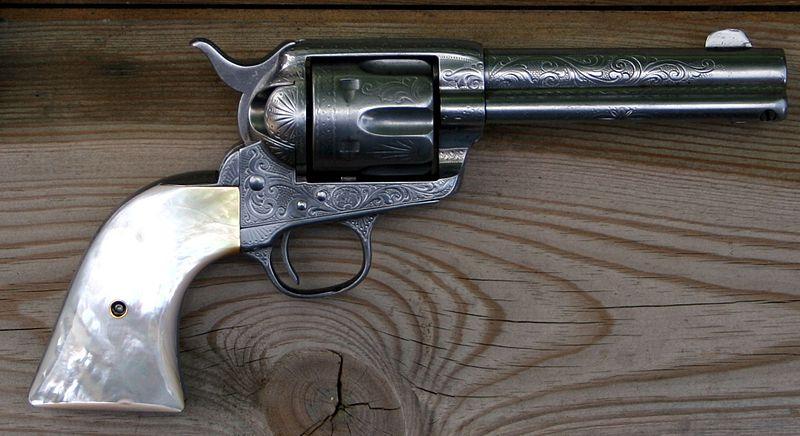
Simplicity With Clout
Loading it was a breeze. Simply cock the hammer to the second click, and open the loading gate on the right. Turn the cylinder, and you could load the chambers with self-contained metal cartridges or use the front slide bar to unload them. No primer caps were necessary. No loose powder had to be tapped into chambers. Once loaded, it was cock-and-fire, cock-and-fire, cock-and-fire, repeat. Typically, an empty chamber served as safety, with five rounds ready and waiting. It was no lightweight either. Colt was able to come up with a sturdy, top-strapped frame that could withstand the powerful discharge of the gun’s six .45-caliber centerfire cartridges. Despite that, it had a beauty, elegance, and purposefulness that drew the military, law enforcement and everyone else.Army Cavalry Colts
With a 7½-inch barrel and weighing in at 2½ pounds, Colt’s SAA cavalry model became the Army’s sidearm of choice. Within two decades of the SAA’s initial production, the Army had purchased 38,000 of them, with cavalrymen fighting what came to be known as the “Indian Wars” a priority for the new weapons:- Soldiers in the Great Sioux War were issued two weapons—a .45-caliber Colt SAA and Model 1873 Springfield rifle.
- In 1874, the 6th and 10th Cavalry were to receive 1,000 each, and 1,000 Colt SAAs were reportedly shipped to San Antonio Arsenal for the 4th Cavalry.
- Custer’s cavalrymen at the Battle of Little Bighorn carried Colt SAAs.
The Artillery Model
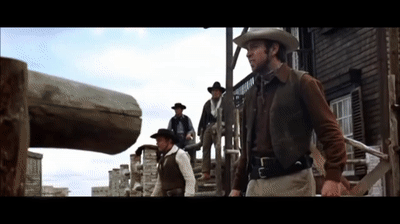
- Starting in 1895, 16,000 to 17,000 of the pistols were refurbished and cut down to 5½ inches for issuing to light artillery battalions.
- Theodore Roosevelt requested Colt SAAs for his Rough Riders, and their charge up San Juan Hill during the Spanish-American War in 1898 included artillery models.
- Units like the 20th Kansas Infantry deployed in the Philippine Insurrection of 1899 to 1902 carried them.
- Then-2nd Lieutenant George S. Patton carried twin Colt Peacemakers while on the Mexican Expedition in 1916.
Civilian Colts
Lawmen, civilians and in-between men alike all wanted the Colts, so models came in a variety of barrel lengths from 7½ inches to 5½, 4¾ and even shorter. Calibers varied as well, with a favorite the Frontier chambered for the same .44-40 rounds that the popular Winchester rifle fired. Men of their time—larger-than-life personalities like the Earps, Pat Garrett, “Buffalo Bill” Cody, Judge Roy Bean and Captain Jack Crawford—became enduring legends, taking their Colt SAAs with them. While production of the pistol tapered and then ended prior to World War II, spaghetti westerns, TV sagas and Hollywood icons like John Wayne romanticized the Colt SAA and brought it back to life and use. Second-generation models date to 1956 to 1974 while third-generation production resumed in 1976. Today, many handgun purchasers and collectors still go out of their way to claim a Peacemaker as their own.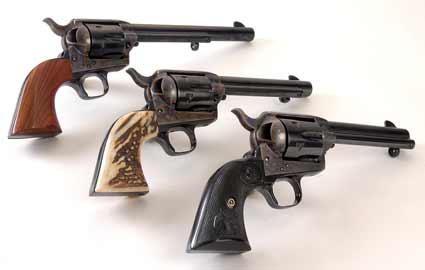
Colt Model 1911
Namesake for its birthright year, the Colt Model 1911 was created to solve a problem—combine power with speed to create a fast, reliable sidearm that could stop crazy in its tracks. John Moses Browning’s powerful semi-automatic single-action creation did it so well that the Colt 1911 has been the weapon of choice for the U.S. Marines Special Forces as well as other members of the armed forces like Navy SEALs, Delta Force and Force Recon. It’s the gun that everyone has or wants, and it was like that from the very start.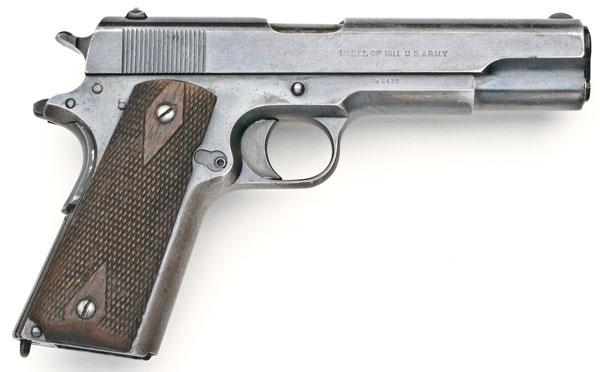
Changing Tactics
The watershed event was the close-quarters guerrilla warfare that U.S. troops faced in the Philippines around the turn of the century. The Army’s .38-caliber Colts were once again found lacking in vital stopping power. The .45-caliber Colt Single-Action Army revolvers came back into action. The consensus, however, was that while nothing less than a .45 would do for power, something more was needed for speed.Browning’s Answer
Browning had the answer, and he proved it by bringing his best game to the military selection trials near the end of 1910:- The pistols under consideration—the 1911 and a .45 made by Savage—were each to fire 6,000 rounds in 100-round increments broken by five-minute cooling intervals; the gun was plunged into a bucket of water.
- Each pistol was to be cleaned and oiled after every 1,000 rounds. Following the 6,000 rounds, each pistol would also be tested for its ability to handle errors, dirt and other malfunctions.
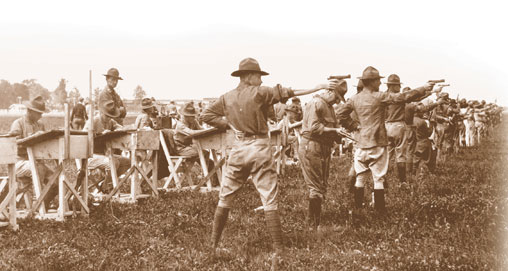
Century of Service
Browning’s precision drop-in design made Colt Model 1911s the gun of World War I, World War II and beyond:- It first saw action in 1916 on the 5,000-troop Punitive Expedition into Mexico to capture Pancho Villa.
- More than 68,000 Colt 1911s were delivered to the Army in early 1917 to be used in World War I on the Western Front.
- For World War II, the U.S. government procured nearly 2 million 1911s for all its armed forces. Interestingly, the 1911’s drop-in design allowed part interchangeability and thus multiple manufacturers for government contracts.
- Durable, thousands of the guns were refurbished in the 1920s and the following three decades.
- Law enforcement—Texas Rangers as well as federal agents—often chose the Colt 1911.
- Forces carried the 1911 in both Korea and Vietnam.
- The Beretta M9 (Our Review Here) eventually took its place as the Army’s signature sidearm in 1985, but the Model 1911 has continued to play a role for many special military and law enforcement units.
Flexibility and Versatility
Browning’s Colt Model 1911 has seen various modifications and calibers over the years—anything from .45 ACP to .38 Super to 9-mm to a .22 training model and more. Other manufacturers have offered their own variants: Smith and Wesson, Kimber, Remington, Springfield, Ithaca, Taurus, Armscor and Sig Sauer are just a start.Prices accurate at time of writing
Prices accurate at time of writing
-
25% off all OAKLEY products – OAKLEY25
Copied! Visit Merchant
Colt M16 Rifle
Baptized by fire amid a storm of controversy, conflict, and frustration, the M16 is the gun that very nearly wasn’t. It was an alien concept conceived by a technical high school graduate turned inventor-engineer outside the normally streamlined realm of ordnance procurement.
Obsolescence
In the 1950s, the Army finally started to embrace that modern combat for infantry happened at fairly short ranges. The M1 rifles and carbines that U.S. soldiers had carried throughout World War II and Korea were relatively slow, heavy and designed for long-range accuracy—1,000 yards versus the more practical and common 120-yard point of engagement. With tensions building in Vietnam’s extreme tropical landscapes, the Army knew it needed something better, something fully automatic—with one trigger pull be able to launch a hail of bullets—yet able to pack a punch while maintaining accuracy.M14 and 7.62mm
Determined to stick with a higher-caliber round, the Army first armed its troops with the M14, which fired a 7.62×51 NATO cartridge from 20-round magazines. However, the gun proved uncontrollable on automatic, the muzzle continuously rising with each successive shot. Despite resistance, the Army found itself revisiting the idea of a lightweight .223-caliber automatic weapon using speed to deliver the desired level of impact. Learn More About the Differences Between the AR-10 and AR-15Stoner’s AR-15
Meanwhile, an engineer at ArmaLite by the name of Jim Sullivan started to rework Eugene Stoner’s AR-10, one of the M14’s former competitors.
Colt’s M16
In the early 1960s, AR-15s were sent to Vietnam in dribs and drabs, first 10, then another 1,000. By 1963, with the Vietnam conflict escalating, then-Secretary of Defense Robert McNamara halted M14 production and sent the AR-15—renamed the M16—into production. Initially, the Special Forces who used it lauded the weapon’s efficiency. The trade-off in weight alone was significant as an M14 plus the typical 100 rounds of ammunition weighed about 17 pounds versus an M16 and 280 rounds—nearly triple the ammunition. Several hitches plagued the M16, however:- Despite McNamara’s intent to have one gun for all services, Colt still ended up producing two variations. The initial order was for 19,000 M16s for the Air Force and 85,000 XM16E1s—M16s with a forward assist—for the Army and other services.
- While ball powder provided the higher speeds desired, it also caused more fouling and was more susceptible to moisture. Ammunition left in guns could swell, burst cartridges and jam weapons.
- Although former campaigns in the Pacific and Korea had shown the necessity of chrome plating the chamber to prevent rust, corrosion, and pitting, the early M16s did not have chrome-plated chambers, the feature having been deemed an unnecessary expense.
- With use, the supposed self-cleaning firearm often jammed in combat, the only remedy to immediately tear it down and clean it.
- The powder used in the M16’s 5.56mm ammo was changed between testing and fielding, with the fielded powder being hotter than what the M16 was designed for. This caused decreased dwell times and resulted in ripped case heads, failure to extract, and other malfunctions. Some units claimed a 50-percent combat failure rate and this lead to soldier injuries, death, and low morale.
M16A1, 2, 3, 4
By 1967, the XM16E1 had become the M16A1. Cleaning kits became standard issue with the “self-cleaning” gun. The firing chambers were retrofitted with chrome-plated ones, and stick powder replaced ball powder. In 1969, the M16A1 finally officially replaced the M14.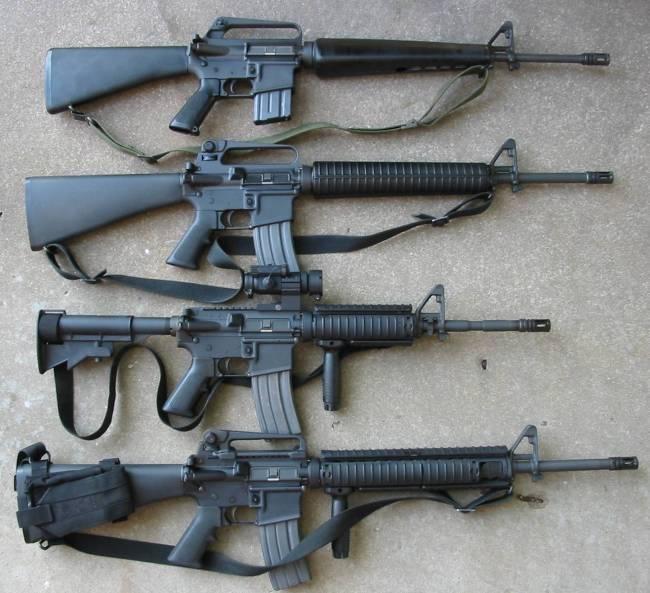
Changing Worlds, Changing Technologies
Just as conflict—why we fight—marks social progress, the firearms we use—how we fight—signal significant technological leaps:- The Sharps rifle brought the idea of one clean, safe, breech-loaded cartridge rather than lengthy, messy and potentially perilous muzzleloading. The Sharps made reloading quick, and the rifleman could do it anywhere—lying down or from the back of a horse.
- The Colt SAA introduced the convenience of .45-caliber cartridges neatly slipped into a revolving cylinder, fully prepared to fire repeated rounds and make them count.
- The Model 1911 gave us reliable semi-automatic single-action fire from a powerful, elegant, durable sidearm with a utilitarian design that remains relevant more than a century later.
- The M16 took us to the extremes, revealing the dark side of technology and its inadequacies. Yet ultimately, it lightened the load, allowing individual soldiers mobility, control, and automatic fire through a streamlined combat rifle made of aluminum, fiberglass, and steel.

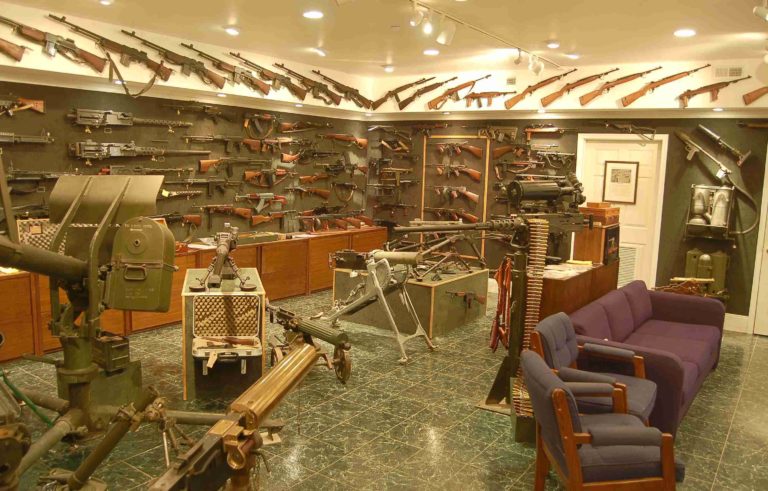

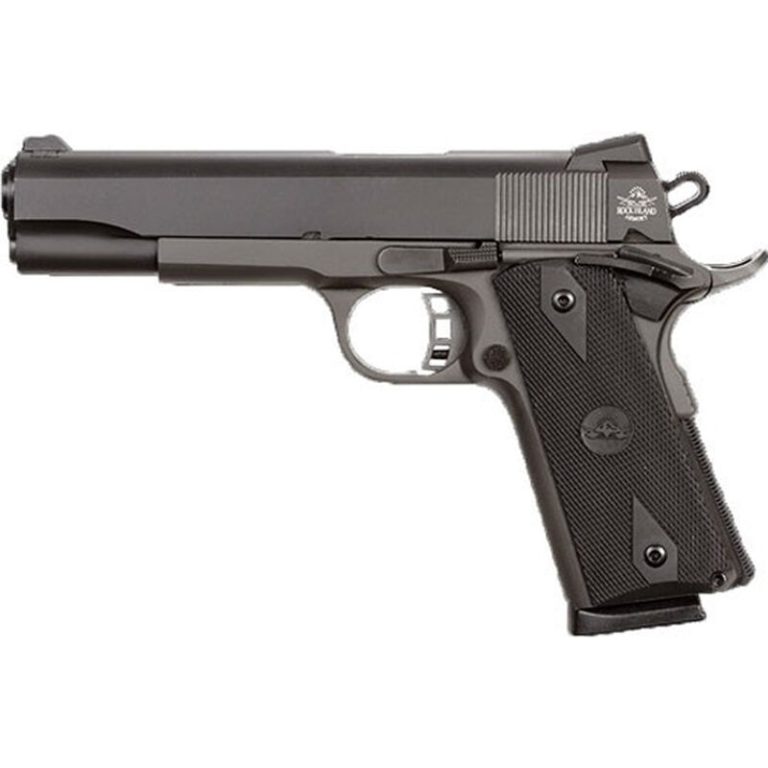







7 Leave a Reply
Good choice of weapons - however, describing the 1911 as a precision drop in design is far from the reality. In manufacture, both Browning in the workshop and Colt in the factory had rather inconsistent standards - the concept of "interchangeable parts" Eli Whitney pioneered hadn't quite yet arrived a the factory floor level. They required hand fitting to operate correctly, which is what the factory could do abundantly well. Labor was relatively cheap and skilled assemblers plentiful.
It was the SINGER contract in ramping up production in WWII that shows the real issues. Singer was contracted to finesse the blueprint for mass production - and was entirely successful when handing off their detailed instructions to Remington Rand and Ithaca. However - Singer itself couldn't do it themselves. Most of their production was scrapped as junk because the parts would not fit within production fitting standards economically.
That is still the issue with 1911's - what we have come to expect of a modern firearm issued to our soldiers is a "MIL SPEC" standard - where parts literally are interchangeable and drop in. The 1911 still has no such blueprint or official standard - it's a compendium of various makers best practices and why installing new parts to anyone's 1911 requires a gunsmith level understanding of the interrelationships and a good set of files. Parts aren't built to a precision fit because nobody knows exactly what that is. There is no one specified universal standard to this day.
Thank you Scott. You helped to clarify what I wanted to know about AR-15 vs M16A1 series rifles.
Thanks, Scott, that was great! It allowed me to recall my first training session with an M 14 and on full auto... and I begin to laugh at the truth of your description.
To pick only four guns that changed the world, now there's a tough call!
I don't disagree with the weapons mentioned, but I think you've had to add a few as well:
First successfully implemented machine gun.
The Mauser action based rifle (take your pick)
The M-1 Garand
The AK-47
Possibly the Sturmgewehr?
The Glock 17
I’m betting someday a Glock 17 will eventually find its place among these world changing historical firearms.
It already is, in my opinion. Glock wasn't the first to try polymer for a handgun but he was the first to get it right. That combined with a slide action that was stone cold reliable helped radically change how we look at handguns.
I would agree. Glock was a revolutionary innovation. Cheap, light, reliable, interchangeable parts. Love 'em or hate 'em, there's no question that they ushered in a new era of handguns.